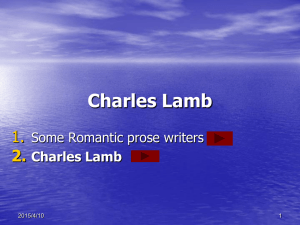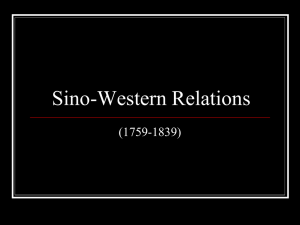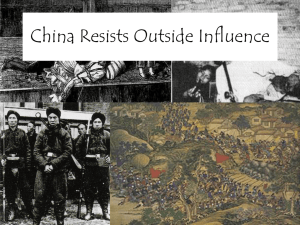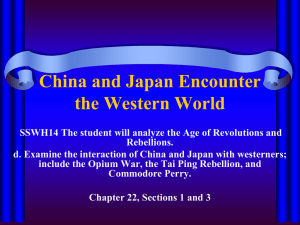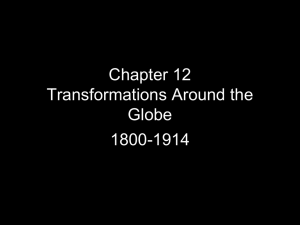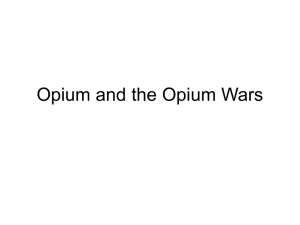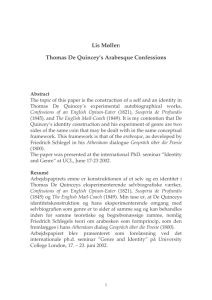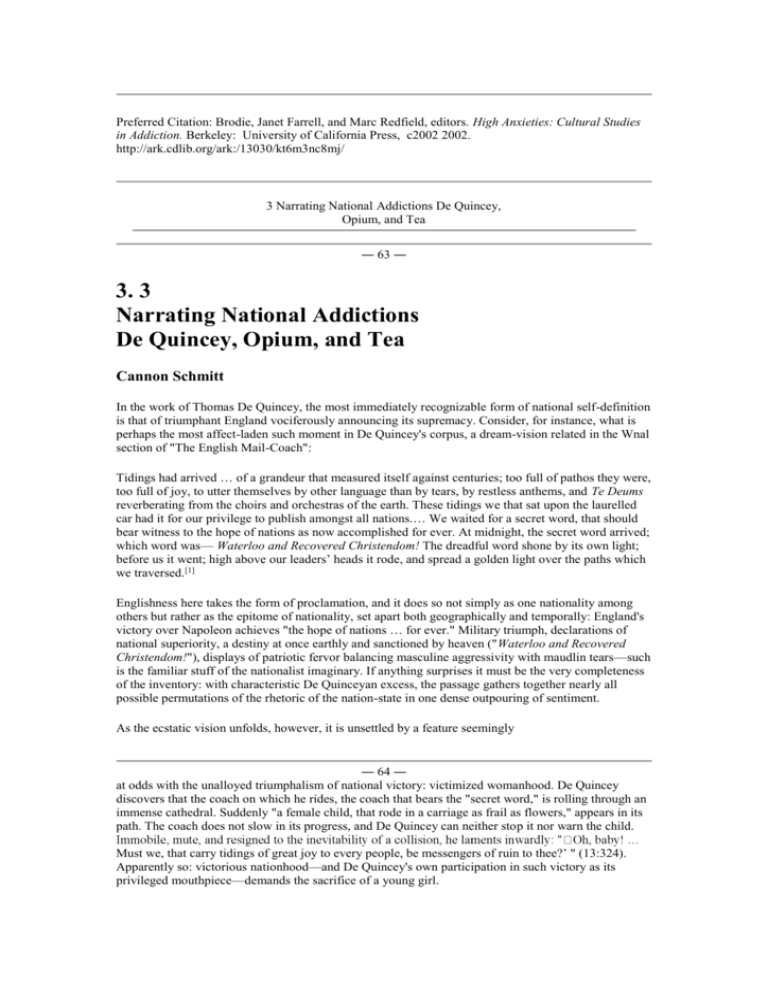
Preferred Citation: Brodie, Janet Farrell, and Marc Redfield, editors. High Anxieties: Cultural Studies
in Addiction. Berkeley: University of California Press, c2002 2002.
http://ark.cdlib.org/ark:/13030/kt6m3nc8mj/
3 Narrating National Addictions De Quincey,
Opium, and Tea
― 63 ―
3. 3
Narrating National Addictions
De Quincey, Opium, and Tea
Cannon Schmitt
In the work of Thomas De Quincey, the most immediately recognizable form of national self-definition
is that of triumphant England vociferously announcing its supremacy. Consider, for instance, what is
perhaps the most affect-laden such moment in De Quincey's corpus, a dream-vision related in the Wnal
section of "The English Mail-Coach":
Tidings had arrived … of a grandeur that measured itself against centuries; too full of pathos they were,
too full of joy, to utter themselves by other language than by tears, by restless anthems, and Te Deums
reverberating from the choirs and orchestras of the earth. These tidings we that sat upon the laurelled
car had it for our privilege to publish amongst all nations.… We waited for a secret word, that should
bear witness to the hope of nations as now accomplished for ever. At midnight, the secret word arrived;
which word was— Waterloo and Recovered Christendom! The dreadful word shone by its own light;
before us it went; high above our leaders’ heads it rode, and spread a golden light over the paths which
we traversed.[1]
Englishness here takes the form of proclamation, and it does so not simply as one nationality among
others but rather as the epitome of nationality, set apart both geographically and temporally: England's
victory over Napoleon achieves "the hope of nations … for ever." Military triumph, declarations of
national superiority, a destiny at once earthly and sanctioned by heaven ("Waterloo and Recovered
Christendom!"), displays of patriotic fervor balancing masculine aggressivity with maudlin tears—such
is the familiar stuff of the nationalist imaginary. If anything surprises it must be the very completeness
of the inventory: with characteristic De Quinceyan excess, the passage gathers together nearly all
possible permutations of the rhetoric of the nation-state in one dense outpouring of sentiment.
As the ecstatic vision unfolds, however, it is unsettled by a feature seemingly
― 64 ―
at odds with the unalloyed triumphalism of national victory: victimized womanhood. De Quincey
discovers that the coach on which he rides, the coach that bears the "secret word," is rolling through an
immense cathedral. Suddenly "a female child, that rode in a carriage as frail as flowers," appears in its
path. The coach does not slow in its progress, and De Quincey can neither stop it nor warn the child.
Must we, that carry tidings of great joy to every people, be messengers of ruin to thee?’ " (13:324).
Apparently so: victorious nationhood—and De Quincey's own participation in such victory as its
privileged mouthpiece—demands the sacrifice of a young girl.
This construction of national identity by way of threatened womanhood invokes what Claudia Johnson
has termed "the Burkean concept of the nation as a fragile body." [2] It does so by drawing on the
generic resources of the Gothic—for the young girl who is to be crushed beneath the wheels of the
coach bearing news of national victory resembles nothing so much as the victimized heroine
characteristic of the Wctions of Ann Radcliffe and other Gothic novelists. [3] "The English Mail-Coach"
is only one of many autobiographical texts in which De Quincey borrows from the Gothic in order to
lend substance and shape to his experiences. The Wrst and most enduringly successful of these
attempts at self-representation, Confessions of an English Opium-Eater (1822; 1856), can accurately be
described as a Gothic autobiography—a text that organizes its material, the life and times of Thomas
De Quincey, on the model of a Gothic novel. And like "The English Mail-Coach," Confessions
suggests that De Quincey found in Gothic narrative a useful way to represent not only the struggles of
the self, but the travails and triumphs of the English nation as well. This double function of the Gothic
is explained by a fatality at the heart of Confessions that inexorably binds De Quincey to the fate of the
nation: his addiction to opium.
Opium, the substance to which De Quincey turned for relief from pain and which eventually tormented
as much as it soothed him, lay behind two of Britain's most far-flung imperial conflicts, the Opium
Wars with China (1839–42 and 1856–58). Contemporary accounts of these wars by British opium
traders and military officers illustrate the expanding currency of the Gothic narrative of victimization in
explaining Britain's imperial and mercantile relations with the rest of the globe. De Quincey's own
journalistic writings on the subject, however, most fully demonstrate the uses to which such a
Gothicization of history and geopolitics might be put. Moreover, in the context of these writings the
national implications of this expansion of Gothic narrative become particularly clear: his essays on the
Opium Wars suggest that to be English is of necessity to be frail. National identity is not secured
through triumphant proclamation, with its "restless anthems" and "Te Deums reverberating from the
choirs and orchestras of the earth."
― 65 ―
Rather, Englishness is constructed as a state of dependence, and the English as inevitably, eternally
subject to victimization.
Si bene calculum ponas, ubique naufragium est
[If you think it over properly, there is shipwreck everywhere.]
PETRONIUS,Satyricon
For De Quincey, catastrophe is omnipresent. The past is comprised of mis-fortune and suffering, "the
deep, deep tragedies of infancy," the "infinite iteration" of the "aboriginal fall" (13:304). The future
holds only despair, for "if from some secret stand we could look by anticipation along [life's] vast
corridors … what a recoil we should suffer of horror!" [4] The present, too, causes dismay, for it "offers
less capacity for [humanity's] footing than the slenderest Wlm that ever spider twisted from her womb"
("Suspiria," 13:361). De Quincey's writings attempt to Wnd an adequate expression for the catastrophic
and an adequate explanation for its ubiquity. As the digressiveness and prolixity of the writings
indicate, the demands of such an attempt could only be met by a restless and exhaustive search for
appropriate language.
The Gothic provides one solution to that search. Although not the only generic mold with which De
Quincey shapes his experience, the Gothic is one of particular power and significance. [5] De Quincey
was steeped in the Gothic: he produced journal entries replete with dark Romantic materials, made
clichéd references to Radcliffe as "the great enchantress" (see, for example, Confessions, 1856, 282),
and wrote his own Gothic novel, Klosterheim (1832), a tale of secrecy and vengeance set during the
Thirty Years War.[6] So far reaching an effect did the genre have on his imagination that his writings
constantly borrow from it in order to give form to his life, his ideas, and, in perhaps the strangest case,
his understanding of international relations. "As an essayist and autobiographer," Eve Kosofsky
Sedgwick has written, "Thomas De Quincey was a great Gothic novelist." [7]
Sedgwick substantiates this claim by identifying in De Quincey's writings a full catalogue of Gothic
conventions—a constellation of related thematic elements that includes "sleep, dreams, live burial, the
unspeakable, [and] the sublime of privation." [8] In keeping with her formalist reading of the genre, she
surveys these elements only to Wnd in all of them a primary "dynamic structure" dominated by the
correspondence between two spaces: "within" and "without." [9] Such a structure is indeed evident in De
Quincey's writings. The more interesting and significant kinship to the Gothic found there, however,
has to do with an obsessive recourse to the genre not, as Sedgwick would have it, in search of the
formal structure of inside and outside,
― 66 ―
but for the promise of a paranoid narrative involving unjust and inexorable persecution.
The centrality of the Gothic as an organizing presence in De Quinceyan autobiography is not evident
on the surface of his works. Confessions of an English Opium-Eater presents De Quincey's life up to
the time of his opium addiction in order to justify that addiction and to explain the origin and contents
of his sleeping and waking visions. As such, its overt structure— clearest in the 1856 revision, but
already present in 1822—is at once geographical and medical. Geographically, the text traces a series
of spatial relocations: from home and family, to Manchester Grammar School, to Wales, to London, to
Oxford, and, ultimately, to the drug that constitutes its own peculiar landscape, opium. The
organization of Confessions is medicalized as well, for each geographic locale is important in its
connection to the stomach ailment that leads to the initial need for opium and, in turn, to De Quincey's
addiction and dreams.[10] "Suspiria de Profundis," one of several pieces written as sequels to
Confessions, carefully articulates the rationale for this pattern: "The work itself [Confessions] opened
with the narration of my early adventures. These, in the natural order of succession, led to the opium as
a resource for healing their consequences; and the opium as naturally led to the dreams" (13:336).
Covertly, however, Confessions organizes itself around recurrent scenes of threat to a helpless victim—
often female, always feminized—and the unavailing efforts of a would-be savior to provide aid. In
most of these scenes De Quincey represents himself as an ineffectual Gothic hero, the character Joanna
Russ has called the genre's "Shadow-Male": like Valancourt in Radcliffe's The Mysteries of Udolpho
(1794) or Vivaldi in The Italian (1797), he repeatedly encounters a woman in danger whom he cannot
protect.[11] This situation is not unique to Confessions; on the contrary, it is played out again and again
in De Quincey's writings. In the passage from "The English Mail-Coach" cited above he watches but
cannot act as his carriage bears down on the doomed girl (13:324); in the Autobiography he recounts
standing by helplessly at that "ineffable" affliction, the death of his sister Elizabeth (54); in "On
Murder Considered as One of the Fine Arts" he dwells for pages on the vulnerability of a "young girl"
stalked by her would-be killer (13:111). Indeed, this scenario dominates his work—and, if the work is
to be believed, his life: the appearance of a "lost Pariah woman," "some shadowy malice which
withdrew her … from restoration and from hope," and his own incapacity to ward off that malice
(Autobiography, 346–47).
De Quincey encounters the central "Pariah woman" of Confessions in London, a city whose terrors are
so forceful that the text adumbrates them well before De Quincey's actual arrival there. The menace of
certain architectural arrangements is a familiar feature of the works of Radcliffe, Matthew Gregory
Lewis, and other Gothicists; their novels frequently invoke
― 67 ―
the aura of malevolent power given off by passages that lead through Inquisitorial dungeons or
Apennine castles. De Quincey invests London with the same aura in his vision of that city in the 1856
version of Confessions. He has stopped at Shrewsbury and must await the Holyhead mail coach in a
large, unoccupied ballroom. This ballroom, transmogrified by night and imagination, foreshadows the
dangers to be found in the English Babylon to which he travels:
But now rose London—sole, dark, infinite—brooding over the whole capacities of my heart.… This
single feature of the rooms—their unusual altitude, and the echoing hollowness which had become the
exponent of the altitude— … threw me into the deadliest condition of nervous emotion under
contradictory forces, high over which predominated horror recoiling from that unfathomed abyss in
London into which I was now so willfully precipitating myself. (46–47)[12]
This nebulous but ominous threat is made good on arrival, for in London De Quincey encounters two
young girls victimized by circumstance. The Wrst of these girls is the nameless waif with whom he
shares poor lodgings and poorer meals. The second, remembered with "far deeper sorrow," is the
London prostitute, Ann.
De Quincey's account of Ann and his inadvertent loss of contact with her, like that of the dark vision of
London's streets as imagined from an empty ballroom in Shrewsbury, makes use of the Gothic to body
forth an episode from his life and, in doing so, to construct a self out of helplessness and victimization.
After spending months in London on the brink of starvation, surviving by means of Ann's
companionship and aid, De Quincey at last determines to borrow money against the future inheritance
specified in his father's will (1822, 54–56). He sets out for Eton to follow up on this determination,
parting from his friend and benefactress but arranging to meet with her on his return and include her in
any success he might have. Subsequently, however, their arrangement proves fruitless: despite days of
earnest searching, he is unable to locate her. The loss of Ann leads to a powerful fantasy of radical
contingency and anonymity, clearly related to fears of mass society, but, if we recall the pervasive
opacity of Radcliffe's and Lewis's convents, castles, and dungeons, just as clearly derived from the
conventions of the Gothic:
This, amongst such troubles as most men meet with in this life, has been my heaviest affliction.—If she
lived, doubtless we must have been sometimes in search of each other, at the very same moment,
through the mighty labyrinths of London; perhaps even within a few feet of each other—a barrier no
wider than a London street, often amounting in the end to a separation for eternity! (1822, 64; 1856,
375)[13]
This "separation for eternity" from Ann reenacts the separation from his sister Elizabeth that De
Quincey suffered as a child. In the Wrst volume of
― 68 ―
the Autobiography he describes his feelings after Elizabeth's death, comparing his situation to that of
the Wandering Jew—both fated to live out a "doom of endless sorrow," the Jew expelled from
Jerusalem and De Quincey cut off from the presence of Elizabeth (43). In the case of De Quincey,
though, separation occurred not once but repeatedly. The loss of Ann, whom De Quincey refers to as
his "sister" (just as he describes other London prostitutes as his "sisters in calamity"), pointedly repeats
the loss of Elizabeth (1856, 359). And, as "Suspiria de Profundis" refers to Ann as the original for the
"lost Pariah woman" of his opium visions (13:222), Elizabeth lies at the base of these as well. But the
question is not one of origins; whether Elizabeth's death set the terms for all the other losses in De
Quincey's life or whether those losses inspired in him the need for an original that he found, after the
fact, in his sister is impossible to determine— and Wnally, perhaps, unimportant. The certainty is that,
in De Quincey's self-representations, loss and the constant threat of loss constitute existence. [14]
This loss, which might at Wrst glance appear to be a free-falling melancholy, in fact takes the specific
form of a structure of persecution consisting of three positions: persecutor, victim, and impotent
onlooker. As Michelle Massé argues in In the Name of Love: Women, Masochism, and the Gothic, such
a structure is typical of Gothic Wctions. Moreover, it corresponds closely to the beater/beaten/spectator
(or sadist/masochist/voyeur) triad described by Freud in "Instincts and Their Vicissitudes" (1915) and
the inhabitants of at least two of the three positions are predictable and static: men are sadists, women
masochists.[15] In his meditations on Elizabeth, Ann, and other women in danger, De Quincey
reproduces this Wxed form of victimization, for frequently he looks on as women suffer at the hands of
men. But elsewhere the inhabitants of these positions are in fact quite volatile. In particular, his
sympathy for victimized women often results in an identification with them so complete that he takes
their place, suffering for them—or, more accurately, as them—the torments of a lost pariah.[16] This
inhabitation of the position of feminized victim is crucial to De Quincey's portrayal of himself: the
English opium-eater is, above all, one who suffers.[17] Moreover, this construction of autobiographical
subjectivity lays the groundwork for a similar construction of English national identity.
A notable instance of De Quincey's victimization appears in the 1856 Confessions and has to do with
his decision to leave Manchester Grammar School. In 1822 he devotes only a few paragraphs to his
time there and is vague about his reasons for running away. In 1856, though, the section detailing this
episode has been greatly expanded. According to De Quincey, bad food and lack of exercise reduced
him to a state of illness so severe that he determined to leave school against the wishes of his mother
and guardians. This decision to "elope," as he calls it, although based in his
― 69 ―
sense of himself as an outcast, is also an assertion of independence, a refusal to suffer. Suffering comes
in the attempt to account for this act to his mother. With this aim in mind he travels from Manchester to
his mother's house in Chester. When he confronts her, however, he is incapable of explaining
himself—and the effort to explain to the reader this inability to explain to his mother requires the
invocation of an Ur-victimization, an archetype of self-betrayal:
If in this world there is one misery having no relief, it is the pressure on the heart of the
Incommunicable. And, if another Sphinx should arise to propose another enigma to man—saying,
What burden is that which only is insupportable by human fortitude? I should answer at once— It is the
burden of the Incommunicable.…Just so helpless did I feel, disarmed into just the same languishing
impotence to face (or to make an effort at facing) the difficulty before me, as most of us have felt in the
dreams of our childhood when lying down without a struggle before some all-conquering lion. (316)[18]
In positing an aboriginal dream of "languishing impotence" common to humanity, De Quincey
expresses his sense of human life as fundamentally catastrophic. More than this, though, he constitutes
the autobiographical subject as victim, and specifically as helpless in the face of the need to speak. By
elevating "the Incommunicable" to the one affliction without succor, the passage exemplifies De
Quincey's self-representation, not as a "Shadow-Male" unable to help a swooning, speechless woman,
but as that woman herself. Further, in making the curious analogy between prostrating oneself before a
lion and facing the inability to explain to one's mother why one ran away from school, De Quincey
connects Gothic victimization to the familial in a way that will recur throughout Confessions and
elsewhere. The ineffable, which Radcliffe and other Gothicists reserve for the most inexpressibly alien
elements of cruel and distant lands, now takes up residence at home, at the feet of an English mother.
There are many other moments in Confessions in which the autobiographer dwells on his own status as
victim, emplotting his life as if it were a Gothic novel and he the novel's heroine. In the passage on
London cited above, for instance, it is the opium-eater himself who cowers before an image of the
"unfathomed abyss" of the metropolis (1856, 47). (If, in the event, London torments two young women
as well, this fact only confirms De Quincey's identification with female sufferers.) The most
remarkable passages of victimization in Confessions, however, are those often-discussed accounts of
the opium dreams involving the Malay. The Wnal section of Confessions, entitled "The Pains of
Opium," documents these dreams in great detail. In them the Gothic pattern of victimization returns,
but this time with a significance that, in light of De Quincey's subsequent role in Britain's relations with
the Far East, can properly be understood as proleptic. For these
― 70 ―
dreams not only continue the portrayal of De Quincey as victim but also identify the Orient as the
source of persecution. In this regard, the following brief excerpt from the "Malay dream" of May 1818
is exemplary:
Under the connecting feeling of tropical heat and vertical sunlights, I brought together all creatures,
birds, beasts, reptiles, all trees and plants, usages and appearances, that are found in all tropical
regions.… I ran into pagodas: and was Wxed, for centuries, at the summit, or in secret rooms; I was the
idol; I was the priest; I was worshipped; I was sacrificed.… I was buried, for a thousand years, in stone
coffins, with mummies and sphinxes, in narrow chambers at the heart of eternal pyramids. I was kissed,
with cancerous kisses, by crocodiles; and laid, confounded with all unutterable slimy things, amongst
reeds and Nilotic mud. (1822, 109)
The strange mélange of Near, Middle, and Far Eastern imagery in this dream illustrates an
Orientalizing imperative that would turn all concomitants of "tropical heat" into signs of a dismaying
and persecutorial East. It also specifies the nature of the danger posed by the Orient: a pollution that
amounts to deracination.[19]
Throughout Confessions De Quincey undertakes a self-fashioning wherein he presents himself as
helpless in the face of persecution—either powerless witness to a woman menaced by some "shadowy
malice" or himself a target of such malice. This dream and others like it at the end of Confessions lend
substance to that shadow. What horrifies De Quincey is the swirling multiplicity of selves he
experiences: "I was the idol; I was the priest; I was worshipped; I was sacrificed." Such horror is tied to
opium: dependence on the drug promotes a destabilization of identity in the autobiographical
subject.[20] And the nature of this destabilization is quite specific: De Quincey's dismay derives from
being an "I" that is also an "it," an Englishman "confounded with all unutterable slimy things, amongst
reeds and Nilotic mud." To fear being "confounded" with all that lives and dies at the bottom of the
Nile is to fear being mixed with, taken for, indistinguishable from what one cannot—for De Quincey,
what one must not—be: an Oriental.
The East, in the eyes of nineteenth-century Europe, was the special province of opium use (De Quincey
on the Malay: "To him, as an Orientalist, I concluded that opium must be familiar" [1822, 91]). [21]
Despite the widespread availability of opium in England, to be an occidental user of the drug could call
the integrity of one's national and racial identity into question. The very title Confessions of an English
Opium-Eater declares as much—though that title may be taken in at least two ways. On the one hand,
it may serve to render the threat of Orientalization harmless by proclaiming from the start the
Englishness of this particular consumer of opium. On the other hand, it may just as well amount to an
admission of contamination: the very necessity of including "English" in the title suggests
― 71 ―
that those who eat opium ordinarily hail from a different part of the globe. This titular rhetoric of
simultaneous innocence and guilt serves as a stylistic analogue for the simultaneous refutation and
confirmation of contamination by the foreign evident throughout Confessions—of the possibility that,
as John Barrell writes of De Quincey, "He was Chinese; he was the Malay that haunted his dreams." [22]
Put another way, the anxiety surrounding addiction to opium concerns an insuperable bodily
dependence on—and hence conflation with—a presence alien to the self but also, more horribly, alien
to the nation.[23]
Thinking the body is thinking social topography and vice versa.
PETER STALLYBRASS AND ALLON WHITE,
The Politics and Poetics of Transgression
Even in the 1822 edition of Confessions, De Quincey was nervously warding off the potentially
deracinating implications of his drug habit and his decision to write about it. Structurally, this
defensiveness appears in an accumulation of preludes to the actual drug "confessions" themselves. The
opium visions treated in Part II of the book are preceded by no fewer than three introductory sections.
Part II itself begins with a few pages of introduction; these, in turn, are preceded by Part I, entitled
"Preliminary Confessions." And even before these preliminaries, an address "To the Reader" appears,
the burden of which is to sketch De Quincey's "apology for breaking through that delicate and
honourable reserve, which, for the most part, restrains us from the public exposure of our own errors
and infirmities" (29).
The pronouns "us" and "our" refer, as the next sentence makes clear, to the English, to whom "nothing,
indeed, is more revolting … than the spectacle of a human being … [openly displaying] his moral
ulcers or scars" (29). Such display is best left to "French literature, or to that part of the German, which
is tainted with the spurious and defective sensibility of the French" (29). The reference here is specific:
as Marilyn Butler notes, the Tory De Quincey "is careful to begin by disassociating his Confessions
from those of Rousseau, the archetypal apologist for himself, who moreover made self-realization and
fulfillment a potentially liberal cause." [24] The defensiveness evident in the address "To the Reader,"
though, attempts a distancing from other nationalities more general than the allusion to Rousseau
suggests. Certainly De Quincey wishes to avoid being associated with the valorization of the self
characteristic of sansculottic Frenchmen and their English Jacobin sympathizers. At the same time, he
is concerned to combat the appearance of involvement with the foreign understood more
― 72 ―
broadly as the source—and perhaps therefore the proper domain—of his addiction.
A passage in "Suspiria de Profundis" that directly addresses opium addiction clarifies the relation
among autobiography, the Gothic, and the anxiety about association with and dependence on the
foreign intimated in the prefatory sections of Confessions. Early on in "Suspiria," De Quincey gives an
account of the realization that he no longer has any hope of overcoming his opium habit. No fewer than
three descriptions of this realization are required adequately to depict it and to convey the despair to
which it gives rise. First, De Quincey recounts a dream in which gates that once provided an exit from
"vast avenues of gloom" are now not only closed and barred against him but also, as if to insist that
what seems to be merely enclosure is actually live burial, "hung with funeral crape" (337). This dream,
in turn, he compares to "the situation of one escaping by some refluent current from the maelstrom
roaring for him in the distance, who Wnds suddenly that this current is but an eddy wheeling round
upon the same maelstrom" (337). The dream represents permanent addiction as the imprisonment of a
solitary wanderer in a barren, crepuscular landscape; the analogy to drowning in a whirlpool retains
and intensifies this sense of immurement but adds the anguish attendant on hopes of salvation suddenly
revealed to be unfounded. Finally, both dream and analogy are glossed with reference to "a striking
incident in a modern novel":
A lady-abbess of a convent, herself suspected of Protestant leanings, and in that way already disarmed
of all effectual power, Wnds one of her own nuns (whom she knows to be innocent) accused of an
offence leading to the most terrific of punishments. The nun will be immured alive if she is found
guilty; and there is no chance that she will not,—for the evidence against her is strong, unless
something were made known that cannot be made known, and the judges are hostile. All follows in the
order of the reader's fears … the judgment is delivered; nothing remains but to see execution done. At
this crisis, the abbess … considers with herself that … there will be one single night open, during
which the prisoner cannot be withdrawn from her own separate jurisdiction. This one night, therefore,
she will use, at any hazard to herself, for the salvation of her friend. At midnight … the lady traverses
the passages which lead to the cells of prisoners …. Suddenly she has reached the door; she descries a
dusky object; she raises her lamp; and, ranged within the recess of the entrance, she beholds the funeral
banner of the holy office, and the black robes of its inexorable officials. (337–38)
As in the dream of gates shut and hung with "funeral crape," addiction here is likened to a permanent
imprisonment that amounts to being "immured alive" (hence the "funeral banner" of the Inquisition).
As in the analogy to the swimmer and the maelstrom, hopes of escape are raised only to be undercut at
the last instant. This "striking incident," however, not only
― 73 ―
echoes but also expands on the representations of addiction that precede it, primarily by dilating a
moment of realization to the extent that it becomes a narrative. De Quincey initially presents a tableau:
a Wgure in a landscape. From this tableau he moves to a scene of drowning that constitutes a narrative
in miniature (hopes of escape found to be baseless) and that may imply a larger narrative structure
(shipwreck, or perhaps—given De Quincey's predilection for classical texts—a revision of Odysseus's
encounter with Charybdis). In the tale of the abbess and the nun, what began as tableau swells into an
entire novelistic episode, complete with characterization, suspense, and a tortuous plot.
This narrativization, in addition to reinscribing what was at Wrst an instant of dismay as a temporal and
developmental sequence, also shifts the story of addiction from the realm of male heroism (the
Homeric shipwreck) to that of female victimization. The opium addict is divided into spectator and
victim, both women: the abbess, "suspected of Protestant leanings, and in that way already disarmed of
all effectual power," and the blameless nun, unfairly "accused of an offence leading to the most terrific
of punishments." Elsewhere De Quincey expresses his loathing of the possibility of "Wnd[ing] housed
within himself … some horrid alien nature" ("The English Mail-Coach," 292n). Here, however,
positing the existence of a dual (and female) nature within provides a strategy of disavowal that allows
him the luxury of denying responsibility for his own addiction.[25] According to the logic of this
episode, that is, one part of the self watches in horror as a second part, innocent but incapable of
proving as much, is tried, found guilty, and punished by "inexorable officials."
As mid-nineteenth-century readers of "Suspiria de Profundis" surely recognized, the "modern novel"
from which De Quincey claims to have taken this incident, if indeed it existed at all, must have been a
Gothic one. Especially remarkable about the appearance of generically Gothic thematic materials in
"Suspiria" is that the displacement which is for Gothic novelists themselves a more or less deliberate
and cultivated exoticism, here—and also in Confessions—provides De Quincey with the ability to
represent a moment of deeply personal importance. It is not just the familiar frisson of Gothic horror
that serves De Quincey's needs. The particularities of the genre's concerns with sexuality, persecution,
monastic Catholicism, and Continental depravity provide a narrative within which De Quincey can
suitably place the story of his unconquerable addiction: the narrative of an innocent female relentlessly
tormented by an unjust—and un-English— authority. In effect, what is at Wrst described as an
essentially private moment is Wnally translated into the arena of the nation. At the end of this passage,
addiction is no longer simply a failure of will on the part of the addict; on the contrary, it takes place at
the intersection of the powerful, and powerfully social, forces of gender, politics, religion, and
nationality. Thus, the
― 74 ―
rather surprising analogy suggested by the details of the episode—its monastic setting, the baleful
presence of the Inquisition, live burial as punishment for a crime that could be sexual, heretical, or
both—is that being an Englishman subject to an unconquerable opium addiction is like being the
innocent, female, and probably Protestant victim of Catholic religious persecution.
In this passage, the foreign threat of opium addiction takes a shape familiar from Gothic novels of the
1790s: a lurid, irrational, Continental malevolence. Increasingly for De Quincey, though, addiction will
be drained of this resonance; in place of the Continent, the East will appear— a far more likely
persecutor, if we recall opium's association with the Orient. As the dreams and visions reported at the
end of Confessions indicate, De Quincey conducts an Orientalization of the Gothic. The most
significant instance of this Orientalization occurs in his essays on the Opium Wars with China—essays
that constitute, at the same time, a gothicization of the Orient. A similar representation of persecution
appears in both Continental and Oriental versions of the tale. As in "Suspiria de Profundis," a tableau
of victimization is narrativized and, in the process, translated from a "male" to a "female" genre.
Despite such similarity, with this Orientalization De Quincey enters a larger arena and plays, as it were,
for higher stakes. From providing a framework for the expression of personal dependence, the Gothic
opens up to convey a sense of national peril. Victimization comes to characterize not simply the
autobiographical subject, but the English nation itself.
Before turning to the Opium Wars, it will be useful to consider briefly the episode in Confessions that
immediately precedes the opium dreams: De Quincey's encounter with the Malay, one of a very few
moments in the text in which the autobiographer is victor rather than victim. Just before relating his
visions he describes being called down from his upstairs study (in Dove Cottage) to meet an
unexpected and inexplicable visitor. He descends to Wnd his servant, Barbara Lewthwaite, and a
neighborhood child confronting a Malay. Characteristically, the confrontation is Wrst rendered as a
tableau, De Quincey himself arranging his subjects and embellishing the details of their appearance:
A more striking picture there could not be imagined, than the beautiful English face of the girl, and its
exquisite fairness, together with her erect and independent attitude, contrasted with the sallow and
bilious skin of the Malay, enamelled or veneered with mahogany, by marine air, his small, Werce,
restless eyes, thin lips, slavish gestures and adorations. Half-hidden by the ferocious-looking Malay,
was a little child from a neighboring cottage who had crept in after him, and was now in the act of
reverting its head, and gazing upwards at the turban and the Wery eyes beneath it, whilst with one hand
he caught at the dress of the young woman for protection. (1822, 91)
― 75 ―
Figure 1. William Mulready, Train Up a Child in the Way He Should Go; and
When He Is Old He Will Not Depart from It. 1841–53. Oil on panel, 25" × 30". ©
The Forbes Magazine Collection, New York. All rights reserved.
In this account, De Quincey is neither feminized victim nor helpless onlooker. The potential for the
victimization of a woman is present—the contrast between Barbara Lewthwaite's "exquisite fairness"
and the Malay's "mahogany" skin and "Werce, restless eyes" seems deliberately provocative, and the
presence of a English child adds still more tension to an already fraught scene—but De Quincey has
this potentiality Wrmly in hand. His meticulous presentation of the encounter arrests its forward
motion and so assures his distance from and control over events. The autobiographer's narration veers
into a painterly stop-time, lingering with mingled interest and fear over a scene in which the oceanic
distances between England and the Orient have suddenly collapsed.
Some two decades later, the academician William Mulready rendered a tableau remarkably similar to
this one as an actual painting. Train Up a Child in the Way He Should Go; and When He Is Old He
Will Not Depart from It (1841;
― 76 ―
repainted 1851, 1853) depicts three very white Wgures—presumably an English child and two
Englishwomen—encountering three lascars on a rural path framed by dark vegetation and towering
cliffs (see Figure 1).[26] One of the lascars makes a gesture of entreaty, and the two women encourage
the child to place money into his outstretched hand. The title of the painting demands that we read it as
a kind of pictorial conduct book for would-be parents: the child receives a lesson in the virtues of
charity, the reluctance he feels in risking contact with the lascar only strengthening the effect of the
lesson insofar as it is a reluctance that can be overcome. But Train Up a Child is particularly charged
because of the way in which it approaches—but, as it were, holds in suspension—the myth of a dark
man raping a white woman, a myth to which the Gothic was instrumental in giving currency. [27] In
accounting for the curious sexualization of this scene, Peter Stallybrass observes that "it is the lascar's
hand, in the center of the painting, which breaks the stark division of black from white, male from
female, and if it is reaching out to receive the child's gift, it is at the same time turned palm up
immediately beneath the breast of the woman on the right." [28]
The threat encoded in Train Up a Child is a threat constantly looming but permanently deferred: if the
painting implies the before and after of narrative movement, it need not—indeed cannot—depart from
the undecidable moment of its present. Like Mulready's painting, De Quincey's account of the
appearance of the Malay raises the specter of rape across racial and national boundaries. But
autobiography, unlike painting, cannot Wnally evade the necessity to narrate. The episode proceeds,
and De Quincey defuses the horrible possibility of victimization that his tableau suggests by turning to
language. With a pretended fluency in eastern tongues, he manages to lord it over both Malay and
servant: "I addressed him [the Malay] in some lines from the Iliad.… He worshipped me in the most
devout manner, and replied in what I suppose was Malay. In this way I saved my reputation with my
neighbours: for the Malay had no means of betraying the secret" (1822, 91). The Incommunicable,
elsewhere the most unbearable of human afflictions, here provides the opportunity to assert dominance
over Malay, servant, and neighbors alike. The inability to explain oneself, earlier compared to lying
down helpless before a lion, is surmounted by transforming a babel of mutually unintelligible
languages—English, Malay, Homeric Greek—into an occasion for triumph.[29]
Subsequently, however, the triumphant self is refused and reconstituted as the persecuted self. The
Malay returns, not as Oriental dupe, but as an endlessly recurring and dizzyingly polymorphous series
of Orientalist nightmares: "This Malay … fastened afterwards upon my dreams, and brought other
Malays with him worse than himself, that ‘ran a-muck’ at me, and led me into a world of troubles"
(1822, 92). We may glimpse in this reversal
― 77 ―
the strategic value of a Gothic narrative of victimization. By inverting his relation with the Malay so
that he is victim rather than persecutor, De Quincey effectively disavows his own power—just as, in
the dream recounted in "Suspiria de Profundis," he disavows responsibility for addiction. A similar
strategy of disavowal characterizes English accounts of the Opium Wars. In those accounts, military
action is required, not to impose the will of England on China by opening its markets by force of arms,
but to protect a weak nation from the inevitability of Chinese aggression.
I know not whether others share in my feelings on this point; but I have often thought that if I were
compelled to forego England, and to live in China, and among Chinese manners and modes of life and
scenery, I should go mad.
DE QUINCEY,Confessions
It is a peculiarly sharp irony of history that in 1821, the year in which Confessions of an English
Opium-Eater appeared in serial form in the London Magazine, the rulers of China made their Wrst
significant effort to stop the importation of opium into their country. Chinese who sold the drug were
arrested and imprisoned or exiled, the export of tea was shut down for some months, and a few British
ships were seized temporarily by the Chinese authorities. That the Chinese should have turned
immediately to the tea trade reveals that the Chinese addiction was tied to a British one: for many
years, China served as a supplier of tea, a commodity that was, by the early nineteenth century,
essential to Britain's social well-being. (One participant in the First Opium War refers to tea as "that
fragrant herb, become now among us Britons almost a necessary of life." [30]) The large and everincreasing British demand for tea—which only the Chinese knew how to grow and prepare—
occasioned a severe trade imbalance that, because the British produced no goods the Chinese would
accept in exchange, Britain was forced to make up in silver. [31]
To alter the situation and put a stop to the flow of silver out of Britain, an officially illegal but in fact
state-sanctioned trade in opium was instituted. According to Maurice Collis (who is perhaps too easily
convinced of Chinese complicity): "For a very long time the East India Company had sought to Wnd a
staple to send to China. But the Chinese had so little use for any of the commodities offered and made
their demand for opium so clear that it became inevitable that it would be satisfied." [32] Grown in the
poppy Welds of British-held Bengal or bought in Turkey, opium was shipped to the South China coast,
where it was sold by the chest to Chinese merchants who, in turn, sold it directly to Chinese
consumers. Once rare in China, the recreational use of opium spread rapidly and widely—due largely
to aggressive marketing by
― 78 ―
British and American smugglers, who introduced the drug to more and more remote areas of the
country. So successful was this trade that the imbalance between Britain and China was reversed in a
relatively brief period. China, once an exporter of tea and an importer of silver, soon found itself
exporting silver and importing opium.[33] The effects on Chinese society were disastrous: the growing
number of opium addicts disrupted both the workings of the national economy and the effective
functioning of the state.[34]
The 1821 attempt by the Chinese to repair such disruption by putting an end to the importation of
opium had little effect. In fact, trade in opium seems only to have become more Wrmly entrenched. As
Beeching notes in The Chinese Opium Wars: "Chinese harassment continued for two years [after
1821].… The easy-going days were over; but the Chinese addicts were unable to stop their craving for
the drug. The trade became more furtive but it increased enormously; by 1835 the number of Chinese
opium addicts was estimated at two million." [35] By the late 1830s the problem had grown more serious
still, and the Chinese again decided to take action. An imperial statute forbidding the trade in and
consumption of opium was issued in 1839.[36] Arrests were made—as in 1821, primarily of Chinese.
This time, however, opium was confiscated from British traders. The drug continued to be sold,
though, until an order was given by Lin Ze-xu, High Commissioner of Port Affairs, to close Canton
entirely to British trade.[37] Lin Ze-xu's action gave the British an excuse to conduct a full-scale war on
the Chinese, a war now known as the First Opium War (1839–42). British troops, many of them
sepoys, defeated Chinese imperial troops in a series of battles that came to an end in 1842 with the
capture of Shanghai and the siege of Nanjing. The Treaty of Nanjing was ratified in 1843; it ceded
Hong Kong to Britain and named Wve ports—Canton, Shanghai, Ningbo, Amoy, and Fuzhou—
[38]
The issue of opium, the
ostensible cause of the war, remained unsettled; it continued to touch off disagreements that would
result, in 1856, in yet another Opium War.[39]
De Quincey, describing how his encounter with a destitute Malay lost in England's Lake District gave
rise to years of terrifying visions, asserts that this Malay "brought other Malays with him worse than
himself, that ‘ran amuck’ at me, and led me into a world of troubles" (1822 92). "A-muck," which
derives from the Malay adjective "amoq," in English usage frequently appears in the phrase De
Quincey employs, "to run a-muck," meaning "to run viciously, mad, frenzied for blood." The Oxford
English Dictionary cites Andrew Marvell's The Rehearsal Transprosd (1672) as the earliest instance of
this usage: "Like a raging Indian he runs a mucke (as they cal it there) stabbing every man he meets."
Subsequent examples establish that the phrase was standard among British commentators on the East.
Indeed, it seems to have been something like an Orientalist cliché.
― 79 ―
Nonetheless, that this phrase should appear frequently in accounts of the Opium Wars is suggestive.
Arthur Cunynghame, in The Opium War: Being Recollections of Service in China (1845), claims to
have witnessed a scene in Singapore in which Malays, "maddened by bad fortune [at gambling], losing
all command over themselves and their actions, committed the most extravagant excesses, stabbing and
maiming all whom chance threw in their way, during which Wts of excitement they were described as
[40]
having ‘run-aJ. Elliot Bingham, in his Narrative of the Expedition to China (1843),
opines:
The Malays, like the Chinese, have a remarkable similarity of feature; in one you behold the face of the
whole nation. If excited by jealousy, or other causes, they are most cunning and revengeful, and when
‘running a muck,’ stab all whom they meet with their kreeses [daggers with ridged, serpentine blades],
which are said to be poisoned with the juice of the upas tree. [41]
These comments are made toward the beginning of these two participants’ accounts of the First Opium
War, separate from their opinions on the war itself. Nevertheless, the comments are striking insofar as
they mirror the logic of Britain's excuse for war—that the Chinese empire had itself "run amuck,"
brutally and rashly destroying British interests, and that it was likely to do so again unless stopped. The
fullest development of this logic was undertaken by none other than the English opium-eater, Thomas
De Quincey.
Peter Ward Fay, in The Opium War 1840–1842, writes of a fever that, in 1842, struck British troops
stationed in the south of China: "Among the dead in Hongkong [sic] was young Horatio De Quincey.…
It was as close as his father, England's most celebrated opium eater, would get to the war that bore in a
sense his name."[42] De Quincey's second son Horatio did indeed die of fever while stationed near
Canton; yet his death was by no means the closest that his father would get to the Opium Wars. On the
contrary, De Quincey was an active propagandist for the British cause from the start. As David
Masson, the editor of the Collected Writings, notes: "China, as known to him by his readings, had
always been an object of his special abomination." [43] One of the ways in which he gave vent to this
"special abomination" was by devoting an immense amount of time and effort to writing up and
disseminating his ideas on the subject of Britain's proper relation to China during the periods leading
up to the First and Second Opium Wars. In these writings, the Gothic tropes that in Confessions were
taken inward and used to represent a life are projected outward and made to serve as an excuse for
war— and, Wnally, as a representation of what it means to be English. [44] The feminized victim of
senseless aggression remains, but she is now not De Quincey's sister Elizabeth, nor his London savior
Ann, nor even De Quincey himself, but that "mighty mother in Europe," England ("Opium Question,"
14:180).
― 80 ―
The Wrst of De Quincey's articles on China, "The Opium Question with China in 1840," appeared in
Blackwood's Magazine.[45] Its author's sentiments as to Britain's proper policy are clear from the outset:
Very Wt it is that so arrogant a people [that is, the Chinese] should be brought to their senses; and
notorious it is that in Eastern lands no appeal to the sense of justice will ever be made available which
does not speak through their fears.… By all means, thump them well: it is your only chance—it is the
only logic which penetrates the fog of so conceited a people. ("Opium Question," 175)
It is war that De Quincey wants, and in the event the British government did not disappoint him. This
bellicose position—and the estimate of the Chinese that lies behind it—is close to that of those who
had most to gain from a war, the opium traders themselves. Two years earlier, in 1838, James
Matheson (a trader with Jardine, Matheson & Co., a prosperous opium smuggling concern founded in
1828) had published an anti-Chinese tract entitled The Present Position and Future Prospects of the
China Trade. Matheson, too, Wnds a rationale for British aggression in the Chinese character, which
he describes as marked by a "marvellous degree of imbecility and avarice, conceit and blasphemy."[46]
Matheson and other opium traders, for reasons of their own, were determined to play down the dangers
of war. Typically, they represented the Chinese military as ludicrously inept, as in the following
excerpt from an anonymous 1836 essay in The Chinese Repository: "What terms can convey an
adequate idea of the monstrous burlesque which the imperial navy presents to our astonished gaze?
Powerless beyond the power of description to ridicule or portray, yet set forth with all the braggadocio
and pretence for which the Chinese are so famous." [47] De Quincey, however, readily admits to the
difficulties posed by a Chinese campaign. In fact, the vulnerability of the English and the inviolability
of the Chinese obsess him. The very characteristics of China that might be taken as disadvantageous in
war, the supposed torpor and barbarism of the "vast callous hulk of the Chinese Empire," provide proof
against invasion: "It is defended by its essential non-irritability" ("Opium Question," 176). England, by
contrast, is "scattered and exposed": "We are to be reached by a thousand wounds, in thousands of
outlying extremities; the very outposts of civilization are held by Englishmen, everywhere maintaining
a reserve of reliance upon the mighty mother in Europe" ("Opium Question," 180). This comparison
between the two nations, with its suggestion of a hulking evil that endangers the "mother in Europe" by
threatening the Englishmen who represent her abroad, maps the Gothic situation of threatened
femininity onto the realm of international politics.[48] The invocation of that "mighty mother," England,
which is at once a refuge and somehow as "scattered and exposed" as its colonists, recalls the nexus
― 81 ―
of frailty, family, and opaque but urgent danger so prevalent in Confessions.[49] Victimization reappears
in "The Opium Question with China in 1840"; it does so, however, not as an event that befalls a
narrator or his "sisters" but as the fate of England itself.
Two crucial passages in the essay feature weak England threatened by malicious and powerful China.
The Wrst involves abasement and victimized women by way of a meditation on the kotou, the ritual act
of kneeling and touching the head to the floor in order to show homage. On the Wrst British mission to
China, in 1793, Lord Macartney refused to kotou before the Emperor, shocking the Chinese but setting
a precedent that would be followed in subsequent missions to China from the British Crown. [50] For De
Quincey, this refusal is of the utmost significance:
Some of our anti-national scribblers at home … insisted upon it, that our English ambassador ought to
have performed the kotou.…Had Lord Amherst [of the second British mission, 1816] submitted to such
a degradation, the next thing would have been a requisition from the English Factory of beautiful
English women, according to a Wxed description, as annual presents to the Emperor. ("Opium
Question," 184)
The leap in logic here is so immense as to be vertiginous: an Englishman abasing himself before a
foreign ruler leads immediately ("the next thing") to the exportation of Englishwomen made to order
for the Chinese Emperor's delectation. In light of De Quincey's other writings, though, such a leap is
also predictable. To show weakness once, to lie down before the lion of the Incommunicable or to
allow the Malay to enter into your dreams, is to ensure the playing out of the Gothic plot on the instant.
Even without the kotou, atrocities against the defenseless are certain to occur when China is involved.
A second passage in the essay in which England stands looking on as China acts the tormentor involves
the narration of an incident that took place in 1784. As De Quincey tells it, a British ship at port in
China, the Lady Hughes (in this context, a name significant in itself), Wred a salute that accidentally
struck and killed a Chinese. Chinese authorities demanded that the man who had Wred the round, an
aged Portuguese gunner, be turned over to them for punishment. The British complied, apparently with
the intention of securing his release after a short time, but the gunner was hanged before they could get
him back ("Opium Question," 187–89).[51] For De Quincey, this incident emblematizes the situation of
England victimized by the foreign. Importantly, it also serves as an indication of the threat of
contamination posed by the Chinese, an example of "the atrocities which … even free-born Britons can
commit, and which, under their accursed system of law, the Chinese can exact" ("Opium Question,"
189). Just as in Confessions the greatest terror of opium resides in its ability to compromise the identity
of its user, so in "The Opium Question
― 82 ―
with China in 1840," the worst aspect of Chinese malevolence is that it will somehow be
communicated to Westerners who come into contact with "this wicked nation" (187). What is more, as
long as contact with China is maintained there can be no respite from incidents such as that involving
the Lady Hughes: "The same scenes are eternally impending" (189). [52]
This certainty of the repetition of Chinese outrages is what legitimizes, in advance, the war on China.
And, lest the fate of a Portuguese gunner in the eighteenth century seem weak as a demonstration of
what might occur should the British fail to "thump" China in 1840, De Quincey quickly transforms this
story into one of more awful torment. The recounting of an atrocity committed in the past provides the
impetus for prophesying future atrocities:
And, if some colonial ship freighted with immigrants, or some packet with passengers, should be
driven out of her course, and touch at a Chinese port, as sure as we live some horrid record will
convulse us all with the intelligence that our brave countrymen, our gentle countrywomen and their
innocent children, have been subjected to the torture by this accursed state. ("Opium Question," 193–
94)
The case of a single man executed for killing a Chinese metamorphoses into a shipload of men,
women, and children tormented by China simply for being English and helpless. The verb tense in the
passage, which hovers between future perfect and past perfect, is indicative: these Chinese outrages
belong to the future; at the same time, they are so certain that the only appropriate way to describe
them is as if they have already happened, as if innocent passengers "have been subjected to the torture."
De Quincey's involvement with China did not end with the ratification of the Treaty of Nanjing in
1843. It flared up again with the advent of renewed hostilities in 1857. In that year he wrote no fewer
than three essays on China for James Hogg's Titan. As Hogg notes, De Quincey even went to the
trouble of collecting the Wrst two of these and reissuing them, together with prefatory material and a
postscript, as a pamphlet of 152 pages in length.[53] The third, uncollected essay, "The Chinese
Question in 1857," was reprinted in the Collected Writings. It repeats—compulsively, almost
deliriously—the essay of 1840 in both sentiment and content, differing only in that what was anger has
now risen to hysteria: "In the case of China this apostrophe—The nations hate thee!—would pass by
acclamation, without needing the formality of a vote" (14:349). The kotou reappears, and this time the
consequences of performing it are even more severe than before: De Quincey goes so far as to assert
that the Opium Wars came about because a Russian ambassador to China foolishly agreed to kotou
before the Emperor early in the eighteenth century (364). The story of the gunner of the Lady Hughes
is repeated in full—again, as an example of what to expect
― 83 ―
from the Chinese (366–67).[54] Finally, there is, again, an impending Chinese violation, for the Chinese
will assuredly "repeat their atrocious insolences as often as opportunities offer" (350).
In the dream-fugue at the end of "The English Mail-Coach," the proclamation of English national
triumph at Waterloo involves the death of a girl. Earlier sections of the essay provide a local
explanation for the necessity of this death, as well as for De Quincey's position as sympathetic but
helpless onlooker: the vision combines, in the form of what De Quincey called an "involute," his many
coach rides during the Napoleonic Wars with an incident in which a coach on which he was traveling
nearly destroyed a carriage carrying a young man and woman. Yet this explanation does little to
account for the incessant recurrence of women in danger not only in "The English Mail-Coach" but in
De Quincey's writings as a whole. The episode echoes and is echoed by many others: the death of
Elizabeth, the loss of Ann, De Quincey's own self-representations as a feminized pariah. In
Confessions, the result of this attention to victimization is the construction of a self whose most salient
characteristic is its openness to threat. Moreover, that threat takes the shape of the foreign: literally,
opium; Wguratively, in the dreamscape of the visions to which opium gives rise, the East and its
corruptions.
If the intent of autobiography is to render visible a distinct self, to represent or construct a subjectivity
that will appear unique, De Quinceyan autobiography achieves this end by continually confronting the
possibility of the complete failure of such a project. [55] The "English Opium-Eater" announced in the
title of Confessions is a being constantly subject to disintegration into some Other because of his use of
opium; yet the possibility of such contamination is what makes him who he is. The fact that opium is
actually imbibed renders this threat particularly visceral: addiction to the drug in this sense amounts to
a literal, physical dependence on the foreign. Gothic plotting provides a way to portray that dependence
as a narrative of victimization, of a helpless woman persecuted by an invincible enemy. [56]
This narrative functions to represent the autobiographical subject, but it is also transposed into the
realm of international relations in order to represent the English nation. In De Quincey's writings on the
Opium Wars, England takes the place of the feminized victim and China assumes the role of
persecutor. But the emphasis De Quincey places, not just on threat but also on contamination, provides
a crucial nuance to an otherwise predictable story. In the Malay dreams at the end of Confessions, the
consequence of dependence on opium is a polluted, compromised self. In the context of the Opium
Wars, an identical pollution threatens the English nation. The agent of this national contamination,
though, is not opium but tea—without which, De Quincey writes in "The English in China," "the social
life of England would receive a deadly wound." [57] And while drinking tea has been
― 84 ―
naturalized (or Anglicized) in a way that eating opium has not—witness the absurd redundancy of any
Confessions of an English Tea-Drinker—the very strength of the connection between England and tea
underscores English dependence on China, which for much of the nineteenth century was the primary
source of the nation's national beverage. As Brian Inglis notes of the First Opium War, "In a sense, it
was really the Tea War."[58]
De Quincey's writings on the Opium Wars embrace rather than deny that dependence, strategically
parlaying the contamination and fragility it implies into a definition of English nationality: Englishness
amounts to frailty, openness to attack. Such frailty is symbolically constitutive: just as it provides De
Quincey with an autobiographical subjectivity, it provides England with a national identity. The
workings of this logic explain the necessity of a girl's death beneath the wheels of the coach that bears
the news of "Waterloo and Recovered Christendom!": the nation, in making itself, must endanger
itself— which it can do most convincingly by endangering what is understood to be at once its weakest
and its most representative citizen.
One source for this strangely catastrophic construction of self and nation is specific to De Quincey and
has to do with his deep conviction of human existence as constituted by pain and suffering. Yet, in the
context of imperialist nation-making, such a conviction has strategic value. Nigel Leask has noted that,
although apparently innocent, De Quincey's tendency to identify with the victim is "very far from being
hostile to imperialism."[59] In the case of England's relation to China, the sense of threat that such an
identification enabled worked to generate, by way of response, a war of conquest. The construction of a
victimized identity at the national level, that is, provided the most powerful nation in the world with a
rationale for aggression based, paradoxically, on a sense of itself as the beleaguered heroine of Gothic
romance.[60]
3 Narrating National Addictions De Quincey,
Opium, and Tea
Preferred Citation: Brodie, Janet Farrell, and Marc Redfield, editors. High Anxieties: Cultural Studies
in Addiction. Berkeley: University of California Press, c2002 2002.
http://ark.cdlib.org/ark:/13030/kt6m3nc8mj/



